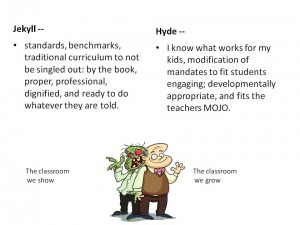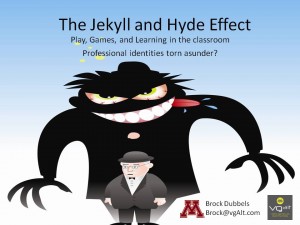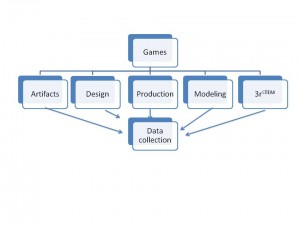
VIDEO GAMES, READING , AND TRANSMEDIAL COMPREHENSION.
Games represent a high interest accessible medium to build comprehension, and in using games we can continue to engage in topics that are complex, provocative and motivating, and not often found in texts designed to be simplified for the sake of decoding. Games will also help to get these students to reconnect with reading and learning, and create a basis for developing and using comprehension strategies. With this in mind, this knowledge and experience of theory can provide an opportunity for educators to bootstrap traditional print-based literacy and engage students in comprehension development.
Brock Dubbels
The University of Minnesota
The Center for Cognitive Sciences
305 Elliott Hall
Minneapolis, MN 55408
(612) 747-0346
(612) 626-7253
Abstract: In this qualitative study, literacy practices of “struggling†seventh and eighth graders were recorded on videotape as they engaged in both traditional and new literacies practices in an after school video games club. These recordings were analyzed in the context of building comprehension skills with video games. The students struggled with reading and are characterized as unmotivated and disengaged by the school, which may be at the root of their inability to use comprehension strategies. Playing video games is viewed here as a literate practice, and was seen to be more engaging than traditional activities (such as reading school text, writing journals, etc.). The conclusion of this observation makes connections to current research in comprehension and provides a basis for teachers to use games to develop comprehension and learning.
Key Terms: situation, event indexing model, causal integration model, ludic, interaction, comprehension, knowledge act, decoding, agency, engagement, identity, self-monitoring, metacognition, transmedial, walk-through, level-up, button-mashing
This selected excerpt comes from:
Dubbels, B.R. (2008) Video games, reading, and transmedial comprehension. In R. E. Ferdig (Ed.),Reference. Information ScienceHandbook of research on effective electronic gaming in education.
The Jekyll and Hyde Effect calls into question approaches to accountability and implementation of mandated approaches to research-validated techniques and assessment in classroom instruction. Dissonance between teachers core beliefs about student learning and these new mandates, as presented to them, may be creating two different identities, two different classrooms, and two different sets of books to satisfy mandates and continue doing what they know works. This study utilized discourse analysis, coding teacher artifacts as outcomes of genre chains with themes from mandates, policy, and law for classroom changes in curriculum and instructional assessment tools, materials, and professional development. The informants from the studies and findings from analysis of the artifacts reveal that many teachers do not feel that what is good for the spreadsheet is good for kids. This tension in core beliefs about learning and instruction need not lead to conflict– integration of assessment and appropriate implementation could enhance teacher and student experience. The transformation of policy to implementation was seen as problematic and led to misunderstanding and conflict, often based upon an inability to see standards, benchmarks, and assessments integrated into engaging, play-like activities such as games rather than the controlled, direct instruction that might cause resistance and disinterest by students and instructors, but easy to identify by administrators. The presentation makes a case for the importance of play in engagement and comprehension through review of literature on intelligence measures and new research on embodiment theory and the indexical hypothesis. Then it give examples of implementation.
New models of comprehension and memory validate the value of active and playful learning for cognitive enhancement and generative transfer. Data on academic performance and engagement measures from five years of games, play, and virtual space learning in K-20 classrooms will be presented in the context of assessment measures using a model for assessing cognitive growth. This is contrasted with educator beliefs, the efficacy of play, and the limitations of models of teacher professionalism creating a Jekyll and Hyde Effect. Though interviews, artifacts, and surveys, K-20 educators have expressed a willingness to embrace games, but have been reluctant to do so publicly for fear of professional reputation, as well as the ability to implement such pedagogical change.
In this presentation, on overview of research, methodology, outcomes, and descriptions of implementation will be presented on how video games and virtual worlds were used to raise standardized reading scores. This evidence, methodology, and experience is presented with outcomes of surveys, interviews, and discourse analysis of teacher artifacts, and presents the institutional experiences of educators balancing the tension of using games and play, and the fear of being stigmatized as unprofessional at their teaching sites. The result begins to create a picture of creating two different sets of books, and two different teaching identities — Jeckyll and Hyde.
This course is an online introduction to Video Games as Learning Tools, a comprehensive course based upon five years of implementation and research. The course builds from three concepts:
- Deep Learning
- Games
- Motivation
The course offers innovative ways to learn and connect engaging instructional strategies, research, and resources for educators, instructional designers, game makers, and people with an interest in games and learning. The course is built from an instructional framework that lists five ways that games can be used for instruction (figure 1).
The course provides an overview of games, and how they can be used as:
- artifacts and texts for study and instruction
- as guidelines for designing instruction (to utilize game design concepts for classrooms, training, and professional development), as well as curriculum tools for content delivery.
- as a means for producing new media and new narratives such as machinima, modding (modifying of the shelf games into new games.
- as models, representation, simulations, and the study of virtual worlds
- and as a portal to developing 3rSTEM, an approach for teaching reading, writing, SCIENCE, TECHNOLOGY, ENGINEERING, and MATHEMATICS
This framework is intended to offer a range of experiences for a variety of learners and familiarity with games, as well as purposes and objectives. The introductory course offers beginners a range of experiences for developing comfort and competence, as well as approaches to using games for instructional purposes, and it offers game enthusiasts and game designers opportunity to gain introduction to research, learning theories, and design techniques.
The course was designed to be self-paced, allow the learner choice and opportunity to choose outcomes and learning purpose, and provide resources and community.
The course has been offered for four years at the University of Minnesota graduate school in the College of Education and Human Development, and embodies accessibility and quality.
Take a look at some comments and recommendations on my Linked in page
The course is available online through the Professional Learning Board in conjunction with Minneapolis Public Schools Alternative Teacher Professional Pay System and the University of Minnesota.
Sign up by clicking the space invader.
 Video Games as Learning Tools
Video Games as Learning Tools
Students interested in graduate credits may purchase three 5000 level graduate credits for half the normal price.
If you email the instructor, coupon codes are available for Minneapolis Public School Teachers and the first 10 Non-MPS students
Play as precursor to comprehension
The process of pretense in play can be very powerful, and it may be the factory of our analogical mind. Vygotsky claimed that it is play that begins to offer liberation from constraint– that we dissociate from teh “real world” into the imaginary world of our play.
In a review of studies by Lewin, it was posited that things dictate to a child what they must do: that we are shaped by tools, rules, relations, context and language; it may be situational constraint that creates direction and action based upon motives and perception; and these can be created through environment.
“but in play, things lose their determining force†and the child may understand the constraints of a condition but gain the ability to act independently of what they see—creating new choices. The act of creating the imaginary and otherness may be an early example of creating mental models of the world that will later be used for inference and reasoning in hypothesis testing—decontextualization and abstraction, allowing not only perception of the context, but perception of the situation and the relevance of that situation in a larger context, creating useful action with the act of perception, and also the act of making meaning.
 This is such a reversal of the child’s relation to the real, immediate concrete
This is such a reversal of the child’s relation to the real, immediate concrete
situation that it is hard to underestimate the full significance. The child does
not do this all at once because it is terribly difficult for a child to sever a kids-play-as-doctor
thought (the meaning of a word) from an object. . . Play provides a transitional
stage in this direction whenever an object (for example a stick) becomes a
pivot for severing meaning of horse from a real horse. The child cannot yet
detach thought from object. (Vygotsky, 1976, p 97).
Thus play seems essential to development, and the role of the pivot ( a toy, representation, or even a game) is important in aiding that early childhood development, where children may move from recognitive play to symbolic and imaginative play, i.e. the child may play with a phone the way it is supposed to be used to show they can use it (recognitive), and in symbolic or imaginative play, they may pretend a banana is the phone. This is an important step since representation and abstraction are essential in learning language, especially print and alphabetical systems for reading and other discourse. There are as many types of play as there are people and cultures. A few types to consider are:
• Recognitive, or Mastery play – learning how to use objects
• Creative play – playing with aesthetics
• Deep play – learning about risk and danger
• Recapitulative play – den building, hiding, climbing
• Dressing up – experimenting with identity
• Rough and tumble play – testing your own strength
For this reason play and gaming, structured forms of play, may be reasonable predictors for comprehension and problem solving. In play, we create models; try on roles; and experience the world in the safety of play. Play may also expand comprehension in surprising ways, but often activities involving play are seen as non-academic—therefore non-educational, lacking rigor and thus, not really learning (Dubbels, submitted).
This presentation was recently offered at Educational Testing Service to share current research on how games can be used for instructional design, content delivery, and as a means for producing media. Emphasis was placed upon games as new narratives that were used as a means to improving problem solving and comprehension. Central to this approach is the use of the Event Indexing Model, Causal Network analysis for measuring comprehension of the digital narrative, and the important role of play in learning. Subtopics included an instructional design model for uses of games for instruction, the integration of play, and a taxonomy of problem solving. Also mentioned is the role of assessment, especially informative assessment, and examples of how games were used in formal and informal instructional settings










